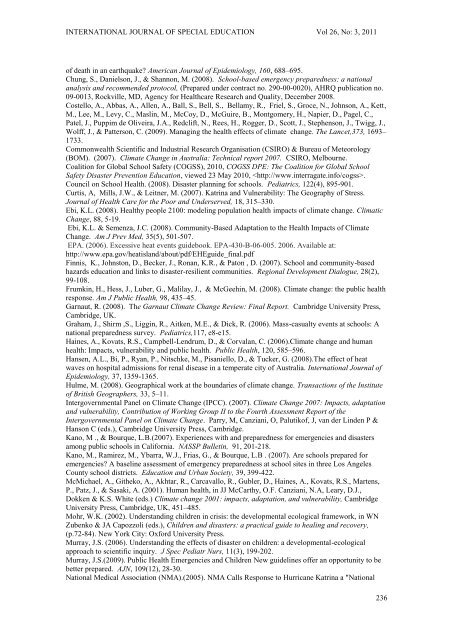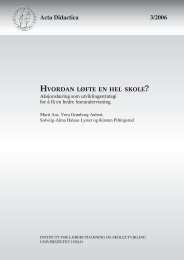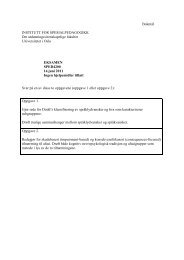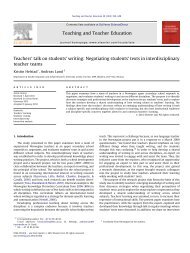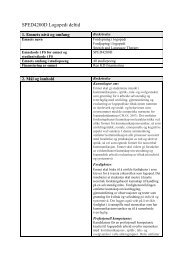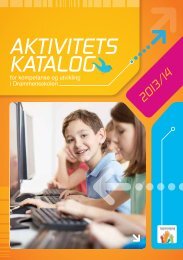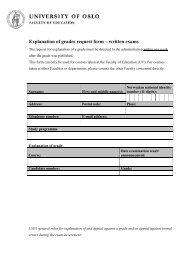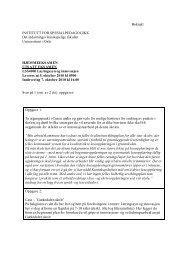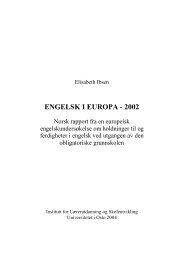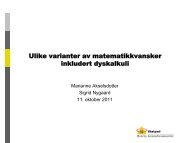International Journal Special Education
International Journal Special Education
International Journal Special Education
You also want an ePaper? Increase the reach of your titles
YUMPU automatically turns print PDFs into web optimized ePapers that Google loves.
INTERNATIONAL JOURNAL OF SPECIAL EDUCATION Vol 26, No: 3, 2011of death in an earthquake? American <strong>Journal</strong> of Epidemiology, 160, 688–695.Chung, S., Danielson, J., & Shannon, M. (2008). School-based emergency preparedness: a nationalanalysis and recommended protocol, (Prepared under contract no. 290-00-0020), AHRQ publication no.09-0013, Rockville, MD, Agency for Healthcare Research and Quality, December 2008.Costello, A., Abbas, A., Allen, A., Ball, S., Bell, S., Bellamy, R., Friel, S., Groce, N., Johnson, A., Kett,M., Lee, M., Levy, C., Maslin, M., McCoy, D., McGuire, B., Montgomery, H., Napier, D., Pagel, C.,Patel, J., Puppim de Oliveira, J.A., Redclift, N., Rees, H., Rogger, D., Scott, J., Stephenson, J., Twigg, J.,Wolff, J., & Patterson, C. (2009). Managing the health effects of climate change. The Lancet,373, 1693–1733.Commonwealth Scientific and Industrial Research Organisation (CSIRO) & Bureau of Meteorology(BOM). (2007). Climate Change in Australia: Technical report 2007. CSIRO, Melbourne.Coalition for Global School Safety (COGSS), 2010, COGSS DPE: The Coalition for Global SchoolSafety Disaster Prevention <strong>Education</strong>, viewed 23 May 2010, .Council on School Health. (2008). Disaster planning for schools. Pediatrics, 122(4), 895-901.Curtis, A, Mills, J.W., & Leitner, M. (2007). Katrina and Vulnerability: The Geography of Stress.<strong>Journal</strong> of Health Care for the Poor and Underserved, 18, 315–330.Ebi, K.L. (2008). Healthy people 2100: modeling population health impacts of climate change. ClimaticChange, 88, 5-19.Ebi, K.L. & Semenza, J.C. (2008). Community-Based Adaptation to the Health Impacts of ClimateChange. Am J Prev Med, 35(5), 501-507.EPA. (2006). Excessive heat events guidebook. EPA-430-B-06-005. 2006. Available at:http://www.epa.gov/heatisland/about/pdf/EHEguide_final.pdfFinnis, K., Johnston, D., Becker, J., Ronan, K.R., & Paton , D. (2007). School and community-basedhazards education and links to disaster-resilient communities. Regional Development Dialogue, 28(2),99-108.Frumkin, H., Hess, J., Luber, G., Malilay, J., & McGeehin, M. (2008). Climate change: the public healthresponse. Am J Public Health, 98, 435–45.Garnaut, R. (2008). The Garnaut Climate Change Review: Final Report. Cambridge University Press,Cambridge, UK.Graham, J., Shirm ,S., Liggin, R., Aitken, M.E., & Dick, R. (2006). Mass-casualty events at schools: Anational preparedness survey. Pediatrics,117, e8-e15.Haines, A., Kovats, R.S., Campbell-Lendrum, D., & Corvalan, C. (2006).Climate change and humanhealth: Impacts, vulnerability and public health. Public Health, 120, 585–596.Hansen, A.L., Bi, P., Ryan, P., Nitschke, M., Pisaniello, D., & Tucker, G. (2008).The effect of heatwaves on hospital admissions for renal disease in a temperate city of Australia. <strong>International</strong> <strong>Journal</strong> ofEpidemiology, 37, 1359-1365.Hulme, M. (2008). Geographical work at the boundaries of climate change. Transactions of the Instituteof British Geographers, 33, 5–11.Intergovernmental Panel on Climate Change (IPCC). (2007). Climate Change 2007: Impacts, adaptationand vulnerability, Contribution of Working Group II to the Fourth Assessment Report of theIntergovernmental Panel on Climate Change. Parry, M, Canziani, O, Palutikof, J, van der Linden P &Hanson C (eds.), Cambridge University Press, Cambridge.Kano, M ., & Bourque, L.B.(2007). Experiences with and preparedness for emergencies and disastersamong public schools in California. NASSP Bulletin, 91, 201-218.Kano, M., Ramirez, M., Ybarra, W.J., Frias, G., & Bourque, L.B . (2007). Are schools prepared foremergencies? A baseline assessment of emergency preparedness at school sites in three Los AngelesCounty school districts. <strong>Education</strong> and Urban Society, 39, 399-422.McMichael, A., Githeko, A., Akhtar, R., Carcavallo, R., Gubler, D., Haines, A., Kovats, R.S., Martens,P., Patz, J., & Sasaki, A. (2001). Human health, in JJ McCarthy, O.F. Canziani, N.A, Leary, D.J.,Dokken & K.S. White (eds.) Climate change 2001: impacts, adaptation, and vulnerability, CambridgeUniversity Press, Cambridge, UK, 451–485.Mohr, W.K. (2002). Understanding children in crisis: the developmental ecological framework, in WNZubenko & JA Capozzoli (eds.), Children and disasters: a practical guide to healing and recovery,(p.72-84). New York City: Oxford University Press.Murray, J.S. (2006). Understanding the effects of disaster on children: a developmental-ecologicalapproach to scientific inquiry. J Spec Pediatr Nurs, 11(3), 199-202.Murray, J.S.(2009). Public Health Emergencies and Children New guidelines offer an opportunity to bebetter prepared. AJN, 109(12), 28-30.National Medical Association (NMA).(2005). NMA Calls Response to Hurricane Katrina a "National236


